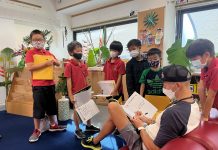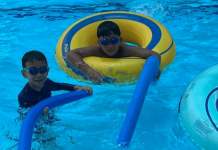Fostering an Attitude of Gratitude
Tips for Parents
How many times have you told your child to appreciate the good things in life and to say “thank you?” Probably a lot. Well, the field of positive psychology is interested in gratitude and its beneficial effects on well-being. In fact, research has shown that people who experience gratitude have more positive emotions, such as joy, love, and happiness; have fewer negative emotions, such as bitterness, envy, and resentment; have increased feelings of connectedness and improved relationships; experience greater satisfaction with school and improved academic achievement; and even have better physical health than people who don’t take the time to notice and appreciate the good things in their lives. Parents can help their children develop the attitude of gratitude through a variety of simple acts and activities. The Fishful ThinkingSM initiative (www.fishfulthinking.com) is designed to equip parents with the tools they need to raise happy, resilient children and helping their children to feel and express gratitude is an important part of that effort.
SIMPLE GRATITUDE EVERY DAY
Model practicing gratitude. Emotions are contagious. Express thanks to your families, friends, neighbors, and strangers, and ensure that your children see you behaving gratefully. Encourage “gratitude” thinking. For example, if your child wins the spelling bee, help her identify all those who helped along the way. Suggest she say “thank you” in person or by writing a note to someone
who made a particular difference.
Share gratitude daily. Make time in the morning or at dinner for the family to share at least one thing for which each person is grateful. This can be balanced with one thing that was difficult that day, but starting with gratefulness reinforces positive connections and resources. Reinforce grateful behavior. Watch for grateful behavior or language in your child. Identify it when it happens and reinforce him for it. For example: “That was thoughtful of you to thank your friend for helping you with homework. Good for you. I’m sure it made him feel good and made your friendship stronger.” Use visual reminders; Put notes in your child’s lunchbox reminding her to be thankful for her health, sibling, dog, etc. Text your child and remind her to count her blessings. Share something for which you are grateful.
FUN AND EASY ACTIVITIES
Make a Grateful Sayings Poster. Get a piece of poster board and write “For This I Am Grateful” in big letters across the top. Ask everyone in your family (and friends and neighbors, too!) to write or draw something on the poster for which he is grateful. It can be something big (like getting an A on a test or winning the soccer championship) or something small (like getting to stay up an extra 15 minutes or taking a fun walk with Dad). Ask each person to put his name or initials under what he writes or draws. Keep the poster up all month so that everybody can continue to add to it. By making this a month-long activity, you are showing your family that gratitude is something we experience every day, if we make the time to notice it! At the end of the month, bring the poster to the dinner table and take turns reading aloud what was written.
Keep a Good Stuff Journal. Most people spend far more time thinking about how they can correct something that has gone wrong, worrying about something that is about to go wrong, or simply replaying a failure or setback, than they do basking in what has gone right and being grateful for their everyday blessings.
You can help your child notice what goes well in her life and build gratitude by keeping a Good Stuff Journal. Analyzing why events go well, what the positive events mean to us, and how we can create circumstances that enable more good things to occur, encourages a consciousness of blessings and gratitude and promotes optimism.
Every night, set aside a few minutes with your child and write down three positive events from the day. These things can be relatively small in importance (“My mom made my favorite dessert tonight”) or relatively large in importance (“My leg has finally healed and my cast got taken off”). The positive events can be things that your child brought on (“I got an A on the test”) or that she witnessed in others (“My sister helped my brother with his homework because mom was busy”). The positive events can also be things noticed in nature (“A cool looking bird was sitting outside my window”).
Next to each positive event that your child lists, write a reflection (at least one sentence) on any of the topics below:
● Why this good thing happened
● What this good thing means to you
● What you can do tomorrow to enable more of this good thing
● What you learned from taking the time to name this good thing
● What ways you or others contribute to this good thing
For more activities to help build gratitude in your children, visit www.fishfulthinking.com and explore the ideas described in the Gratitude Works Program at your child’s school, sponsored by the National
Association of School Psychologists (www.nasponline.org).





